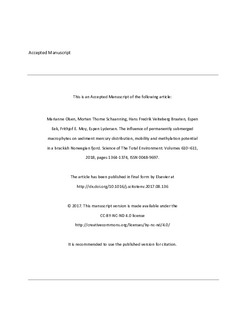The influence of permanently submerged macrophytes on sediment mercury distribution, mobility and methylation potential in a brackish Norwegian fjord
Olsen, Marianne; Schaanning, Morten; Braaten, Hans Fredrik Veiteberg; Eek, Espen; Moy, Frithjof Emil; Lydersen, Espen
Peer reviewed, Journal article
Accepted version
Permanent lenke
http://hdl.handle.net/11250/2574256Utgivelsesdato
2018Metadata
Vis full innførselSamlinger
- NGI articles [1061]
Originalversjon
Science of the Total Environment. 2018, 610-611 1364-1374. 10.1016/j.scitotenv.2017.08.136Sammendrag
Macrophytes are shown to affect the microbial activity in different aqueous environments, with an altering of the sediment cycling of mercury (Hg) as a potential effect. Here, we investigated how a meadow with permanently submerged macrophytes in a contaminated brackish fjord in southern Norway influenced the conditions for sulfate reducing microbial activity, the methyl-Hg (MeHg) production and the availability of MeHg. Historically discharged Hg from a chlor-alkali plant (60–80 tons, 1947–1987) was evident through high Hg concentrations (491 mg Tot-Hg kg− 1, 268 μg MeHg kg− 1) in intermediate sediment depths (10–20 cm) outside of the meadow, with reduced concentrations within the meadow. Natural recovery of the fjord was revealed by lower sediment surface concentrations (1.9–15.5 mg Tot-Hg kg− 1, 1.3–3.2 μg MeHg kg− 1). Within the meadow, vertical gradients of sediment hydrogen sulfide (H2S) Eh and pH suggested microbial sulfate reduction in 2–5 cm depths, coinciding with peak values of relative MeHg levels (0.5% MeHg). We assume that MeHg production rates was stimulated by the supply and availability of organic carbon, microbial activity and a sulfide oxidizing agent (e.g. O2) within the rhizosphere. Following this, % MeHg in sediment (0–5 cm) within the meadow was approximately 10 × higher compared to outside the meadow. Further, enhanced availability of MeHg within the meadow was demonstrated by significantly higher fluxes (p < 0.01) from sediment to overlying water (0.1–0.6 ng m− 2 d− 1) compared to sediment without macrophytes (0.02–0.2 ng m− 2 d− 1). Considering the productivity and species richness typical for such habitats, submerged macrophyte meadows located within legacy Hg contaminated sediment sites may constitute important entry points for MeHg into food webs. The influence of permanently submerged macrophytes on sediment mercury distribution, mobility and methylation potential in a brackish Norwegian fjord
